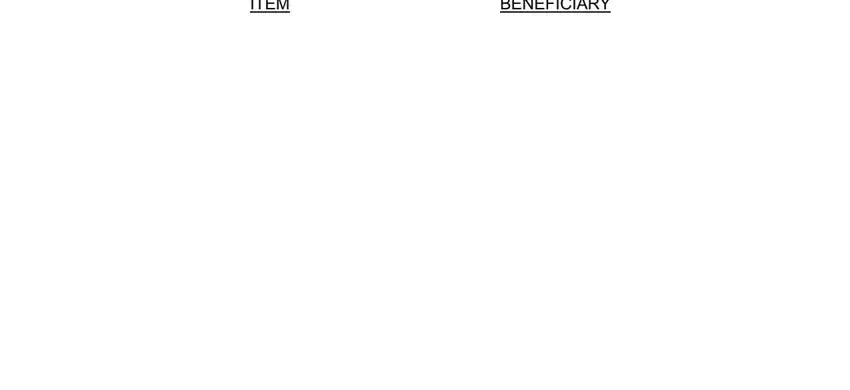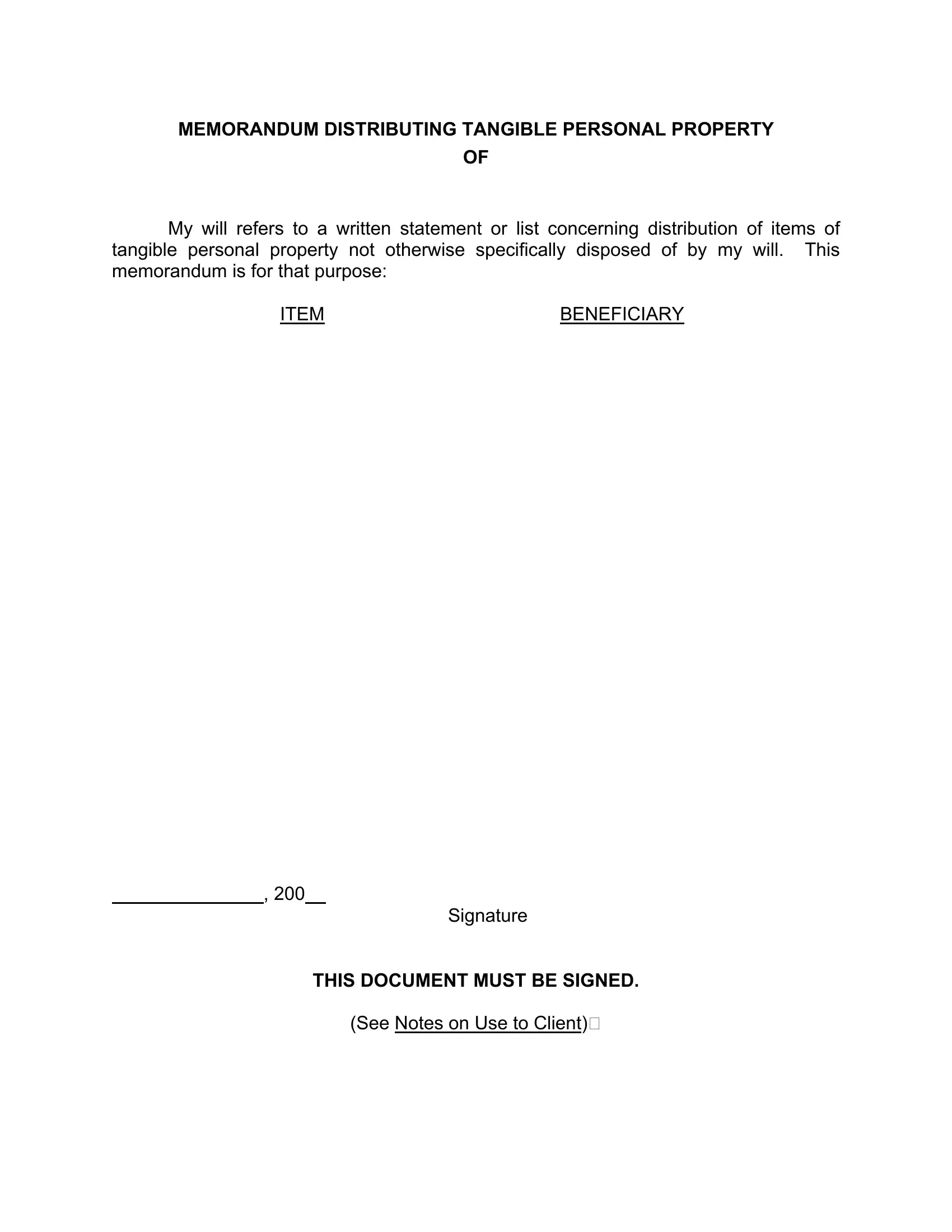MEMORANDUM DISTRIBUTING TANGIBLE PERSONAL PROPERTY
OF
My will refers to a written statement or list concerning distribution of items of tangible personal property not otherwise specifically disposed of by my will. This memorandum is for that purpose:
ITEMBENEFICIARY
, 200
Signature
THIS DOCUMENT MUST BE SIGNED.
(See Notes on Use to Client)
NOTES ON USE TO CLIENT
For Tangible Personal Property Memorandum
The Colorado Probate Code expressly permits the use of a separate memorandum to dispose of tangible personal property. If you want to use such a memorandum rather than itemize the disposition of tangible personal property in your will, you should read and follow the instructions listed below:
1.For such a memorandum to be effective, your will must expressly refer to a disposition by memorandum.
2.The memorandum should not include items already specifically disposed of by you in your will.
3.THIS MEMORANDUM CANNOT BE USED TO DISPOSE OF MONEY (WHICH WOULD INCLUDE BANK ACCOUNTS), EVIDENCES OF INDEBTEDNESS, DOCUMENTS OF TITLE, REAL ESTATE, OR SECURITIES.
4.The memorandum may be used to dispose of motor vehicles, trailers, semi- trailers, trailer coaches, and motor homes. It may also be used to dispose of tangible personal property used in a business.
5.The memorandum should be dated and signed by you.
6.You should clearly describe items you have listed on your memorandum so that they are easily identified and not confused with another similar item.
7.Each beneficiary should be identified by his or her proper name and relationship to you. The address of the beneficiary should be added, particularly if the beneficiary is not closely related to you, so that proper identification is insured.
8.You should consider providing for alternative beneficiaries if the first named beneficiary does not survive you.
9.You may change the beneficiaries or property designated in the memorandum. Changes may be made by a new memorandum patterned after the form given to you by your attorney. As of this date, it is uncertain whether coins and currency collections are tangible personal property or money. Before disposing of cash and currency collections, consult with your attorney.
10.If your will provides for your spouse to receive all items of tangible personal property, both spouses should execute similar memoranda so that both spouses' items will be listed in the memorandum of the surviving spouse and the listed items will be received by the intended beneficiaries following the death of the last spouse to die.
11.This form of memorandum is authorized by section 15-11-513, C.R.S. It refers to the memorandum as a separate writing, written statement or list referred to in a will.
12.Memoranda may not be used for bequests of real estate, money, evidences of indebtedness, and securities. To avoid ambiguity and possible failure of a gift by memoranda, we recommend the disposition of coin and currency collections by specific devise in the will.
13.Memoranda may be used to dispose of a motor vehicle, as defined in section 42- 6-102(7), C.R.S., as well as trailers, semi-trailers, trailer coaches and motor homes. They can also be used to dispose of property used in a trade or business.
14.Memoranda must be signed by or be in the handwriting of the testator.
15.Items listed in memoranda should be clearly described and the beneficiaries must be identified with reasonable certainty.
16.Memoranda need not be in existence on the date the will is signed. Section 15- 11-513, C.R.S., permits a memorandum to be altered by the testator after its preparation, but it is recommended that a new memorandum be prepared.
17.Dating memoranda is not required. Dating may resolve conflicts, however, where more than one memorandum has been made.
18.Memoranda need not be witnessed; however, in some cases, it may be appropriate.
19.Memoranda may be voided without affecting the will.
20.The location of the memorandum article in the will validating use of the memorandum will affect whether or not the beneficiaries designated in memoranda will receive the described gift of personal property. If, for example, the memorandum provision article appears following an article which gives all of the decedent's property to a surviving spouse, the beneficiaries designated in the memorandum will receive the gifts of personal property only if there is no spouse surviving. In some instances, this will be desired and in such event, both spouses should execute similar memoranda so that both spouses' items will be listed in the memorandum of the surviving spouse and the listed items will be received by the intended beneficiaries following the death of the last spouse to die. In other instances, it will be desired that the memorandum beneficiaries receive the gifts of personal property at the death of the decedent who has prepared the memorandum, whether or not a spouse survives. In those cases, place the memorandum in an article appearing before the residuary provisions.
21.With respect to written memorandum forms, the new section 15-11-603(3), C.R.S., indicates that anti-lapse will not apply to provisions in written memoranda. Many memorandum forms make specific provisions for lapse of gifts. A testator may desire an alternative beneficiary in the event that the named beneficiary is deceased at the death of the testator. If no alternative beneficiary is named, the gift passes to the residue.




